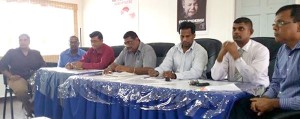Keeping children in school
Written by Gina Webmasters, Published in News, A GINA Feature- January 12, 2015, Source - GINA

Education in Guyana is provided largely by the Government of Guyana, through the Ministry of Education and its arms in the 10 different regions of the country, and is subsidised from nursery to secondary levels. The local education system is a legacy from its time as British Guiana, and is similar to that of the other member states of the Caribbean Community, which are affiliated to the Caribbean Examinations Council (CXC).
It has been recognised that the provision of free education, and constant interventions would enable the raising of the bar where education is concerned, and the People’s Progressive Party Civic (PPP/C) has been doing just that.
Literacy
The knowledge that a child’s ability to read is positively related to opportunities for academic and vocational success has resulted in a revised literacy plan targeting children’s reading skills. The ultimate aim is to have all children able to read and learn by the end of the fourth grade.
Learning to read by that grade is a key force in determining whether a student will go on to graduate from high school, attend and graduate from college and achieve future success in the work force. It is important to note that not only does grade level reading have a significant impact on a student’s educational career; it has broader ramifications for their economic livelihood in an increasingly competitive economic environment.
Nutrition
Nutrition is a major influence on physical and mental growth and is a main factor in promoting lifelong healthy eating; hence Government commenced its National School Feeding Programme in 2010, which targeted all Nursery and Primary Schools in most of the regions. The programme consists of biscuits and juices, which are both locally made.
Children at a City school enjoying biscuits and juice
Schools such as those in Annai, Karasabai, Aranaputa and St. Ignatius, receive a daily nutritious snack of cassava bread, peanut butter and fruit juice. After its success, the hot meal project was later implemented in Regions 1, 7, 8 and 9. It was developed since it was recognised that students travel long distances to attend school which in some cases was costly and resulted in low attendance rates and increasing school dropouts.
Billions of dollars have been expended on the National School Feeding Programme, in an effort to ensure improved attendance and attentiveness in the classroom.
Providing uniforms nationally
The provision of school uniform vouchers to children residing on the coastland and in riverain communities, along with the provision of uniform materials to hinterland communities is also another means by Government to provide assistance to parents to ensure that children attend school and complete their education. The School Uniform Programme ensures one school uniform is given to every child attending a school in the public education system from nursery to Grade 11.

A parent signing for a uniform voucher
The Ministry of Amerindian Affairs is responsible for the programme in the hinterland and it procures school uniform for communities in Regions 1, 7, 8, and 9. This programme has positively influenced school attendance and performance in the Hinterland, and has created job opportunities for residents. The women are given the task of sewing the uniforms for the various schools, for which they are paid.
Free text books
Text books are essential to students developing their knowledge base, and this is another avenue whereby the Administration has been providing students of all stages with assistance. This precludes the need for parents to purchase the expensive books.
In an effort to make all children literate by the end of Grade 4, and because of the prohibitive price of books, two new series have been written; the Roraima series for nursery age children and the Atlantic Readers for primary aged children. The Roraima Readers include readers, work books, writing skills workbooks, flash cards, charts, and assessments. This series is currently being used, while the Atlantic series will be introduced this year. These books were written by local experts and they may to be used internationally, but were written with the Guyanese/Caribbean child in mind.
Core text books for Mathematics, English, Social Studies and Science have been procured for every child in all public primary schools. Additionally, relevant Mathematics and English texts were procured for each student from Grades 7 to 11.
Because We Care
The cash grant initiative ‘Because We Care’ is meant to provide more support to parents with school age children and increase their disposable income. This is in fact the first programme of its kind in the Caribbean and indeed anywhere else in this part of the world where every public school child is entitled to this benefit.

Students of a hinterland school benefiting from the hot meal programme
The Ministry of Education, since its launch in October 2014 has distributed 135,969 vouchers, each valued $10,000. The initiative is meant to provide additional support to parents with children, attending a nursery, primary, or secondary school in the public education system. This programme targets 188,406 families. This grant can be used to meet such costs as transportation, and will provide added impetus to raising enrolment and attendance rates, in addition to having the effect of increasing the disposable incomes of the parents of school aged children.
HEIP
The launch of the Hinterland Education Improvement Project (HEIP) has seen the Ministry seeking ways in which to improve the results of education in the identified regions. This is being done through consultations which would enable residents to tell of their needs and suggestions to improve education results in students in hinterland regions.
Nursery level children in a hinterland location decked out in their uniforms. The material was provided by the Education Ministry



